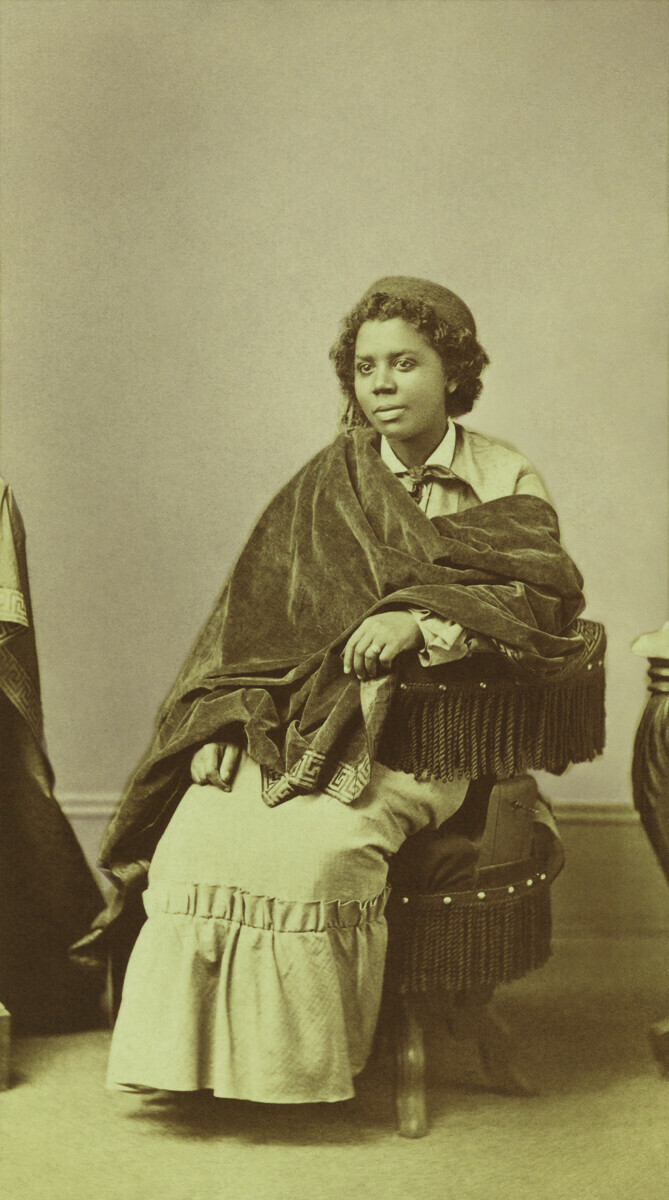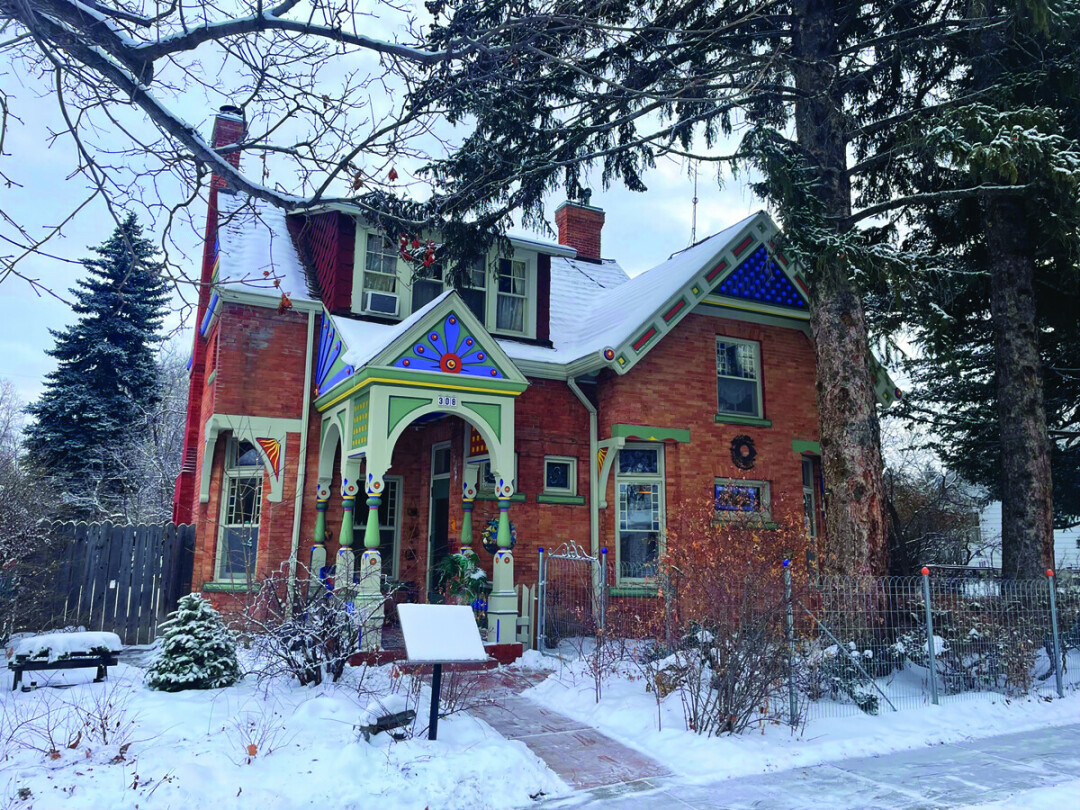Samuel Lewis: Showman, Musician, Businessman, Barber
Crystal Alegria | Thursday Feb. 1st, 2024

Samuel Lewis came to Bozeman, Montana Territory in 1868 or 1869 and set up a barber’s chair in the Northern Pacific Hotel, where he waited on tables to pay his board, and worked behind his barber’s chair between meals. He eventually opened a barber shop on Main Street, where the Fechter building stands today.
Lewis was born in the West Indies on May 19, 1835. His father was a West Indies Frenchman; his mother was part African, and a descendant of the Narragensett people of New York state. Samuel’s family came to the United States, settling in Newark, New Jersey when he was a child. Tragedy struck when his mother died in 1844 and his father soon after, in 1847, leaving Samuel and his young sister, Edmonia, as orphans. To make a living, Samuel traveled with a circus as a tightrope walker and bare back rider for six years. In 1852, like many others at this time, he traveled west to San Francisco, leaving his sister Edmonia in the care of the S. R. Mills family.
In San Francisco, he opened a barber shop on Commercial Street in the heart of San Francisco. He stayed in the bustling city for two years, then left to travel Europe and back to the West Indies. While in Europe he studied legerdemain, or slight-of-hand tricks, under an eminent French professor in Paris. Upon his return to America and the west, he traveled throughout the California mining camps with a famous minstrel company.
In 1866, he arrived in Montana Territory, touring the mining camps, including Virginia City and Helena, ultimately settling for a time in Elk Creek, a mining camp thought to have great potential. He bought property and erected a building, but soon realized that, though there had been potential, the claims were not as productive as originally thought, so Lewis moved to the more prosperous and larger city of Helena. 
While living in Helena, Lewis plied his trade as a barber and entertainer, as we can see from newspaper advertisements and articles. Lewis lived in Helena until 1869, when he made the move to Bozeman, where he purchased property on Main Street and opened a barber shop that would be a constant on Main Street until his death.
Music was always a part of Lewis’ life. He played multiple instruments including the banjo, which brought him world-wide fame, according to the Montana Record-Herald newspaper. They wrote, “Sam Lewis, the champion banjoist, has a reputation which is not confined to America. He has played, with success, in every place of note in the civilized world, and is consequently a big card. As his sister, Edmonia, is with the sculptor chisel, so is Sam with the banjo.”
Though he had left his sister Edmonia in the care of others, Samuel oversaw her life and education from afar, making sure she was adequately cared for during his time in the west. In 1859, when Edmonia was about 15 years old, Samuel enrolled her in the secondary Oberlin Academy Preparatory School for a three-year course. After that, she entered Oberlin Collegiate Institute (now called Oberlin College). This was one of the first institutions in the United States to admit women of color. Here is where Edmonia began to study art. Due to racism and prejudice, she left Oberlin without finishing her degree, and moved to Boston in 1864, where she began to study sculpting under Edward Augustus Brackett.
Edmonia’s earliest sculptures represent abolitionists and Civil War heroes including Colonel Robert Gould Shaw, who was the commander of an African American Civil War regiment. She created a bust of his likeness which was purchased by his family. She made reproductions of the Shaw piece and sold those for fifteen dollars apiece. This was her first success, and provided her with the means to move to Rome.
Edmonia had her first solo exhibition in 1864 and went on to become a world-renowned sculptor, spending most of her career in Rome. In 1876, she returned to the States to participate in the Centennial Exposition in Philadelphia. For this, she created one of her most famous pieces, The Death of Cleopatra. This piece now resides in the Smithsonian American Art Museum.
Meanwhile, Samuel continued his theatrical life while in Bozeman. He was a member of the Fort Ellis Amateur Minstrel and Dramatic Troupe, and was always involved in the musical performances offered in Bozeman.
Lewis also invested in real estate, constructing two cottages on what was then called Templar Avenue; today, the two houses are addressed as 209 and 211 South Tracy Avenue. Prominent local builder and architect Byron Vreeland finished the construction of the two structures for Lewis in 1879. Lewis rented the cottages out to prominent Bozeman residents including Reverend Lewis, the rector of Saint James Episcopal Church, and Judge S. W. Langhorne. By 1880, Lewis had another residence under construction, also on Templar (Tracy) Avenue, with an estimated cost of $4,000. Upon completion, he also rented out this residence. Unlike the twin houses at 209 and 211, this house is no longer standing. 
Samuel built a residence for himself in 1881 at 308 South Bozeman Avenue, which consisted of a simple wood frame gable-front-and-wings house. Two years later, at age 48, Samuel married Malissa Railey Bruce. While it was Lewis’ first marriage, Malissa had been previously married to Charles Bruce, with whom she had six children. Charles had died of pneumonia in 1882, and is buried in Bozeman’s Sunset Hills Cemetery. Malissa and Samuel set up housekeeping in his residence on South Bozeman Avenue with Malissa’s five living children (she had lost a baby in 1881). Together, Samuel and Malissa had one child, Samuel E. Lewis, who was born in November, 1886.
With a large family, Samuel began to add on to his home. The Bozeman Weekly Chronicle noted on September 9, 1885; “Sam Lewis is building an addition to his residence.” By 1890, Lewis had completed his additions, creating a Queen Anne style showplace on South Bozeman with brick veneer, stained glass, spindle work, and a sunburst appliqué over the front entry door. Inside, he added a parlor with a beautiful, frescoed ceiling.
In 1893, Samuel was put forward as a possible candidate for Aldermen of the Fourth Ward. Advocating for Lewis, a Bozeman Courier article says, “Sam Lewis is not only an old-time citizen, but he is deservedly noted for his industry, enterprise and excellent business qualifications. He has done as much towards advancing the permanent interests and healthy growth of the city as any other citizen with the opportunities and means at his command.” But a week later, for reasons unknown, the newspaper reported that, “Sam Lewis declines to be considered a candidate for alderman in his ward. He thanks his friends for their solicitude in his behalf.”
As the end of the century neared, Samuel became sick in March of 1896, suffering from a strangulated hernia. As it became critical, a difficult surgery was performed, and a piece of his intestine was removed with the hope of saving his life, but he only lived for one day after the surgery. He died on March 28, 1896, and is buried in the Black section of Bozeman’s Sunset Hills Cemetery.
Samuel and Malissa’s son, Samuel E. Lewis, died in 1916 at the young age of 30 from heart failure while visiting Chicago. Malissa lived until 1927, when she passed at the age of 75. Lewis’ sister, Edmonia, lived in Rome for much of her sculpting career and said; “I was practically driven to Rome in order to obtain the opportunities for art culture, and to find a social atmosphere where I was not constantly reminded of my color. The land of liberty had no room for a colored sculptor.” Edmonia lived in Paris from 1896 to 1901, then in London before her death in 1907. She is buried in St. Mary’s Catholic Cemetery in Kensal Green, London. 
Today, the former residence of Samuel Lewis still stands at 308 South Bozeman Avenue, and has a National Register sign in the front yard that highlights the life of Samuel Lewis and the history of the house. The house is beautifully cared for by the Tenney Family, who have loved and maintained this house and the Lewis legacy for many years. Two of the houses he built as rental properties still stand at 209 and 211 South Tracy Avenue.
Samuel left a legacy in Bozeman as an upstanding citizen, a businessman, a family man, a talented musician and actor, a Bozeman founding father, and a friend to many. We remember his achievements and honor his legacy and place in Bozeman’s diverse history.
| Tweet |
